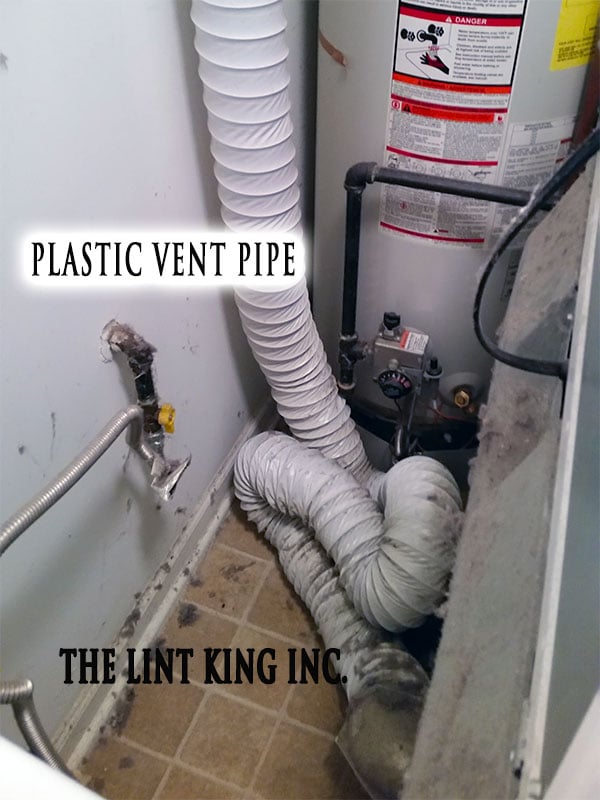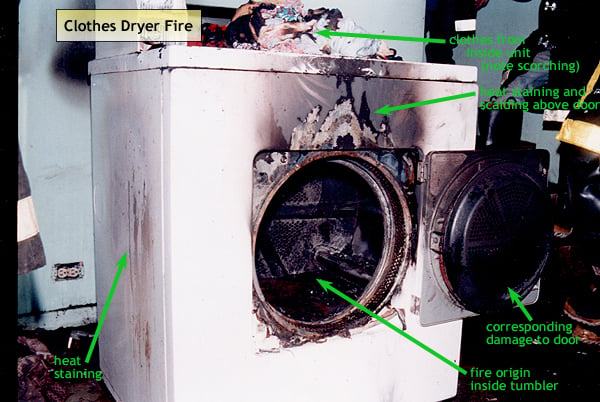Clothes Dryer Vent Safety & Installation Tips
�
Clothes Dryer Exhaust Venting Materials
 Plastic Dryer Duct Safety The Lint King Inc.
Plastic Dryer Duct Safety The Lint King Inc.
Clothes Dryer Vent Safety.� The minimum allowed clothes dryer exhaust vent piping diameter for all installations is 4″.
A Plastic Flex Duct is a flexible dryer vent duct with a spring wire covered with plastic.
I’ve seen this material used in older homes as “dryer vent ducting.” Plastic should not be used!
There’s a variety of materials that I’ve observed that are bad or even a safety concern in your home.� Like: Reducers, PVC pipe, Excessive Length or Turns, Chicken Wire
- Reducers like 4″ to 3″ will cause a 25% or more reduction in airflow and increase the cost of operations.
- PVC can build up a static discharge and ignite the lint, causing a fire!
- Long Ductwork will reduce airflow and cause long dryer times.
- 90� Turns in clothes dryer pipes create turbulence, reducing efficiency, and are where lint collects!
- Chicken Wire is often used to block birds or squirrels.� They also trap lint!
Foil�Flex Duct�clothes dryer vent transition duct materials come in two types.
- Gas Dryer Foil Flex should only be used to transition between the wall and the dryer.
- Bathroom Foil Flex should not be used with clothes dryers.
Advantages of Using Metal Dryer Vent Ducts
The Lint King Inc. prefers rigid-solid metal dryer vent ducting where possible for Clothes Dryer Vent Safety.� TLK’s next choice is a semi-rigid metal pipe.� I found this material easily dented or crushed, breaking open, and leaking lint and other gases into your home’s interior.
The bottom line is that having smooth interior surface vents provides advantages for clothes dryer efficiency and fewer repairs.� How they help…
- Provide better airflow and a smoother internal surface
- Decrease accumulation of lint debris inside the duct system
- Reduce drying time and operating costs
- Fire-safe due to solid metal and foil-taped joints
- Less likely to be punctured and leak back into the room
- Maintenance is better, and a cleaning doesn’t damage plastic or foil
Clothes Dryer and dryer Vent Temperatures
Wow!� Did you know that heat builds up with a blocked dryer airway?� Check out this article on CLOTHES DRYER TEMPERATURES� that illustrates the various temperatures inside your clothes dryers.
Inside a clothes dryer are parts like a motor, controller, drum, heater, and many safety features.� Modern clothes dryers have sensors for regular, safe operation and during unsafe conditions that risk a dryer fire in your home!
 Clothes Dryer Fire
Clothes Dryer Fire
High temperatures will cause appliance failures, such as a humidity sensor, temperature control system, blower motor, fan, or timer control unit!
A table of the typical and�unsafe clothes dryer operating temperatures.
Modern Clothes Dryer Temperatures
Clothes Dryer Vent Safety
|
Gas and Electric
Clothes Dryer
Cycles & Functions |
Normal� / Safe Clothes Dryer Temperature |
Abnormal / Unsafe Clothes Dryer Temperature |
The air inlet to the clothes dryer
into the heating element |
64 �F to 75 �F |
� |
Operating temperature for a
clothes dryer heat element |
250-400 �F |
� |
| Air temperature entering the drum |
175 �F |
� |
| The air temperature inside the drum |
125-135 �F |
> 392 �F |
| Air temperatures in the exhaust vent |
125-135 �F |
> 392 �F |
~Exhaust temperatures at an
interior, exterior wall |
113-130 �F |
> 392 �F |
| ~Clothes dryer exhaust vent�outlet interior surface temperature |
100-145 �F |
> 392 �F |
| Thermochemical decomposition temperature range |
� |
200-300 �F |
The safe operating temperature on
inside a clothes dryer cabinet |
<= 392 �F |
> 392 �F |
The NFPA reported that from 2010-2014, U.S. municipal fire departments responded to an estimated 15,970 home fires involving clothes dryers or washing machines yearly.� These fires resulted in annual losses estimated at 13 civilian deaths, 440 civilian injuries, and $238 million in direct property damage.
As a percentage of all home fires and associated losses, fires involving clothes dryers or washing machines accounted for 4% of fires, 1% of civilian deaths, 3% of civilian injuries, and 4% of direct property damage.
Maximum Clothes Dryer Vent Lengths and Turns
Keep the vent duct as short and straight as possible for maximum clothes dryer vent safety.
Industry standards recommend that the maximum “concealed” rigid metal ducted clothes dryer vent length be no more than 25 feet.
The effective length of a dryer duct with bends increases by 2.5 feet for each 45� turn and 5 feet for each 90-degree curving.
If a clothes dryer vent is 25 feet long and has three 90� elbows, which is very common, it would have an equivalent measure of 25 + (3×5)� = 40 feet!
Dryer vent duct routing mistakes
Clothes dryer exhaust vents should be directed to the building exterior.� Do not vent the clothes dryer indoors nor into an attic, crawl space, or other enclosed areas.
Get the Clothes Moisture and lint Outside, Away From the Interior of Your Home!
The manufacturer of the clothes dryers emphasized that the venting needs to carry the moist air to the building’s outside.� Did you know that homeowners who use a dryer vent’s air to increase the building’s indoor humidity level are?
… In ViolatIon of� Local Code and Manufacturer’s Instructions!
Do not vent directly into the attic, basement, crawl space, or any of the building’s interior walls.
This will lead to moisture condensation on surfaces like the insulation, building framing members, walls, floors, or attics.� Adding clothes dryers and laundry moisture in these locations will undoubtedly encourage mold growth.
Even if the dryer exhaust vent extends outdoors, an improperly installed crashed or disconnected dryer vent can leak lint and moisture.� Even carbon monoxide (CO) can leak into the building.
Rusty or brown leak stains in ceilings may be traced to water leakage from a clothes dryer vent in the roof!
Complete details about clothes dryer exhaust vent installation can be found in this article at�Clothes Dryer Exhaust Vent Installation.
Clothes Dryers that Vent into the Attic
Don’t vent clothes dryers directly into the attic space because you’re putting moisture into the attic.� Now, mold growth can start on wood surfaces and the attic insulation.
Clothes Dryers that Vent into the Crawl Space
The clothes dryer vent exhaust shouldn’t be hung near the screen vent opening of the crawl space.� Lint will clog the crawl space vent, and the damp dryer exhaust air will create mold and mildew on the ceiling.
Local Dryer Vent Cleaning in Northern Illinois